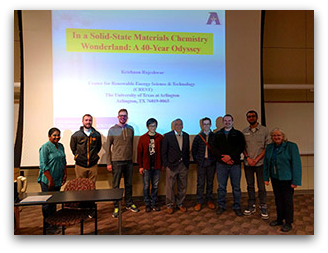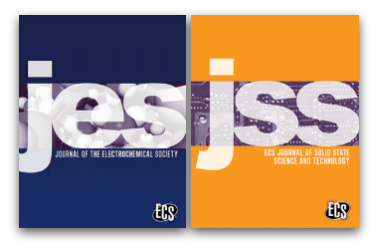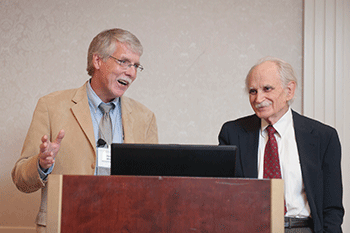 ECS senior vice president and professor at the University of Texas at Arlington, Krishnan Rajeshwar, recently visited the University of Iowa’s ECS Student Chapter to discuss research, meet with faculty, and deliver a lecture on solid state materials.
ECS senior vice president and professor at the University of Texas at Arlington, Krishnan Rajeshwar, recently visited the University of Iowa’s ECS Student Chapter to discuss research, meet with faculty, and deliver a lecture on solid state materials.
Rajeshwar’s research touches areas ranging from the first demonstrated use of ionic liquid electrolytes for electrode stabilization in photoelectrochemical (PEC) devices to novel approaches to the electrosynthesis of binary and ternary semiconductor thin films.
Recently, his studies have addressed the use of solid state chemistry principles to the design of electrodes for energy conversion and solar fuel generation. Rajeshwar applied some of these concepts to his lecture, “In a Solid State Materials Chemistry Wonderland: A 40-Year Odyssey,” which he delivered to the ECS Student Chapter at the University of Iowa.
(MORE: Check out additional research by Rajeshwar.)
Throughout his visit, Rajeshwar met with the faculty from the university’s departments of chemistry and engineering, discussed science and current events with student members, and was hosted to dinner by ECS 2nd vice president Johna Leddy.


 In an effort to more quickly disseminate breakthrough research and bolster the scientific discovery process, ECS has established
In an effort to more quickly disseminate breakthrough research and bolster the scientific discovery process, ECS has established  ECS recognizes outstanding technical achievements in electrochemistry and solid state science and technology through its Honors & Awards program. There are many deserving members of the Electrodeposition Division among us and this is an opportunity to highlight their contributions.
ECS recognizes outstanding technical achievements in electrochemistry and solid state science and technology through its Honors & Awards program. There are many deserving members of the Electrodeposition Division among us and this is an opportunity to highlight their contributions.
 It’s always questionable to blog about something that is gaining attention because it’s illegal, but that’s the case with the latest crop of articles about open access in popular media. While the scientific community has been debating the merits of open access for a while now, the business behind scientific publishing is getting a lot more attention lately because of Alexandra Elbakyan, a graduate student from Kazakhstan who has hacked into hundreds of scholarly journals.
It’s always questionable to blog about something that is gaining attention because it’s illegal, but that’s the case with the latest crop of articles about open access in popular media. While the scientific community has been debating the merits of open access for a while now, the business behind scientific publishing is getting a lot more attention lately because of Alexandra Elbakyan, a graduate student from Kazakhstan who has hacked into hundreds of scholarly journals.